
Holy Monastery of Hilandar
Meaning of "Hilandar" is probably derived from Greek word chelandion, which is a type of Byzantine transport ship, whose skipper was called "helandaris". This name took the monastery after the monk who had founded it and most probably was a helandaris before. The monastery was founded at the end of the 10th century.
In 1198 an imperial edict of Byzantine emperor Alexios III granted it to the Serbian prince Stephan Nemanja and his son, who had both taken the habit at Vatopedi as Simeon and Sava. Since then it has been one of the most important spiritual centers of the Serb nation.
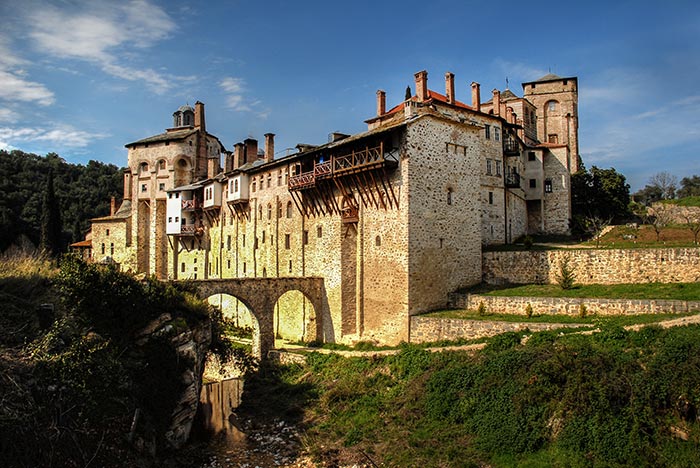
Upon securing Serbian authority within the monastery, Saint Sava and Saint Symeon jointly constructed the monastery's Church of the Entry of the Lady Theotokos into the Temple between 1198-1200, while also adding Saint Sava's Tower, the Kambanski Tower and Saint Symeon's monastic chambers - cells. Saint Symeon's middle son and Saint Sava's older brother, Serbian Grand Prince Stefan "the First-Crowned" King provided financial resources for this restoration.
As Hilandar's founder, Saint Symeon issued a special founding charter or chrysobulls. Following 1199, hundreds of monks from Serbia moved to the monastery, while large pieces of land, metochions and tax proceeds from numerous villages were provided to the monastery, especially from the Metohija region of Serbia.
Saint Symeon died in the monastery on February 13, 1200. His body remained in Hilandar until 1208 when his myrrh-flowing remains were transferred to Serbia and interred into the mother-church of all Serbian churches the Studenica Monastery according to his original desire.
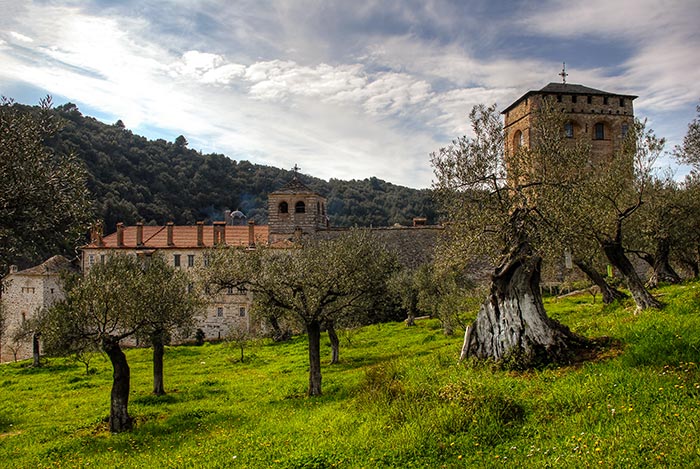
Following the relocation of Saint Symeon's remains, what would eventually become world-famous grapevines began growing on the spot of his old tomb, which gives to this day miraculous grapes and seeds that are shipped all over as a form of blessing to childless married couples.
Saint Sava travelled to Serbia to secure more resources and support for the monastery. He also undertook a voyage to the Holy Land where he visited The Holy Lavra of Saint Sabbas the Sanctified in Palestine. There he received Hilandar's most revered relic, the miraculous icon of Three-handed Theotokos painted by St. John of Damascus. According to St. John of Damascus' last will, he ordered the Mar Saba monastery brethren to add this miraculous icon to the old prophesy made by the monastery's founder Saint Sabbas the Sanctified.
Saint Sabbas the Sanctified adjured his monks centuries earlier to donate the icon of the Milk-feeding Theotokos and his hegemon cane to the "namesake monk of royal blood from a faraway land" who would experience, during his pilgrimage to the monastery, the fall of his hegemon cane to the floor, previously affixed above his grave, while venerating icons and praying on that spot.
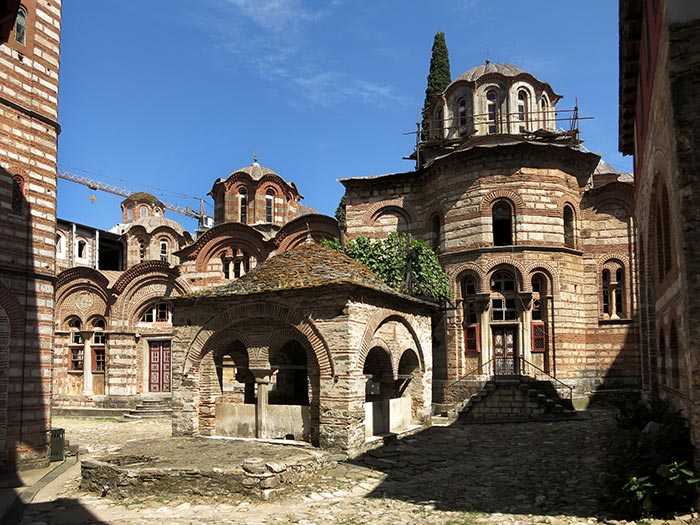
At the time of Serbian King and Emperor Dusan, the whole Mount Athos came under his sovereign power. This is the period of Hilandar's greatest prosperity. The Emperor significantly supported the monastery and bequeathed a number of land possessions in Serbia and Greece to it. Ever since his reign and until today, Hilandar owns one fifth of the whole landmass on Athos. In addition to the Emperor, Dusan's aristocracy also supported the monastery.
In 1347 Emperor Dusan sought refuge in Hilandar while escaping the plague epidemics that devastated the Balkans. He also took his wife Empress Jelena with him, thus creating a precedent and violating the strict tradition that bars women from stepping into Mount Athos. The oral tradition holds that during her stay in Hilandar, the Empress was not allowed to plant her foot on the Athos ground as she was carried around by her escort. By the end of the 14th century, Hilandar served as a refuge to numerous members of Serbian nobility.
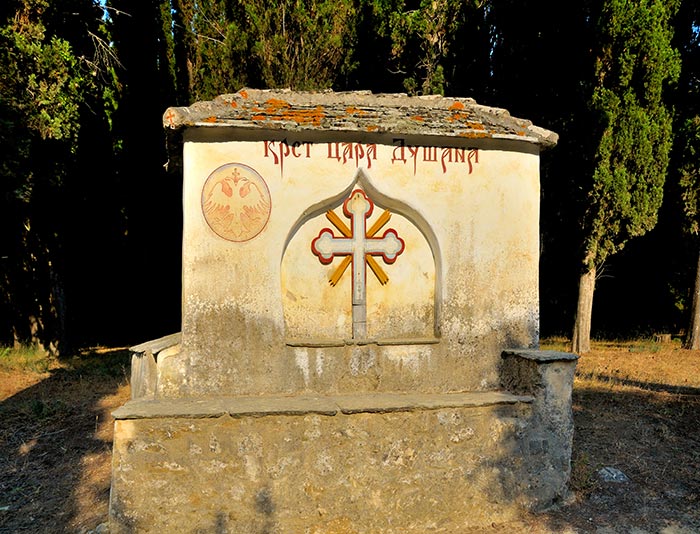
Nobleman from Albania John Castriot donated tax proceeds collected from 2 villages in Macedonia to the monastery in 1426. His sons were among the remaining local Christian Orthodox aristocrats supporting Hilandar. As John Castriot and his sons purchased adelphates securing their rights to retire and reside in the monastery, the Hilandar Saint George Tower, became known as the "Albanian Tower" in their honor. Upon retiring and taking monastic vows, they joined the Hilandar brotherhood and spent there the rest of their life.
In the 17th century the number of Serbian monks dwindled, and the disastrous fire in 1722 saw a decline. Hilandar was headed by Bulgarian monks. In this monastery that Saint Paisios of Hilandar began his revolutionary Slavonic-Bulgarian History. The monastery was dominated by Bulgarians until the late 19th century.
However, in 1896 Serbian Tsar Alexander visited the monastery and impressed by historical past, contributed to the monastery, and population of Serbian monks grew quickly. They once again became the inhabitants of Hilandar. In 1913, Serbian presence on Athos was quite big and the Athonite Protos was the Serbian representative of Hilandar.
The present Katholikon, dedicated to the Presentation of the Virgin, was built in 1293, frescoed in 1319-1320 and contains the tomb of the founder St Simeon. The refectory, also built in 1293, was frescoed in 1623 by Georgios Mitrophanovits, though remnants of the 14th century wall-paintings have survived.
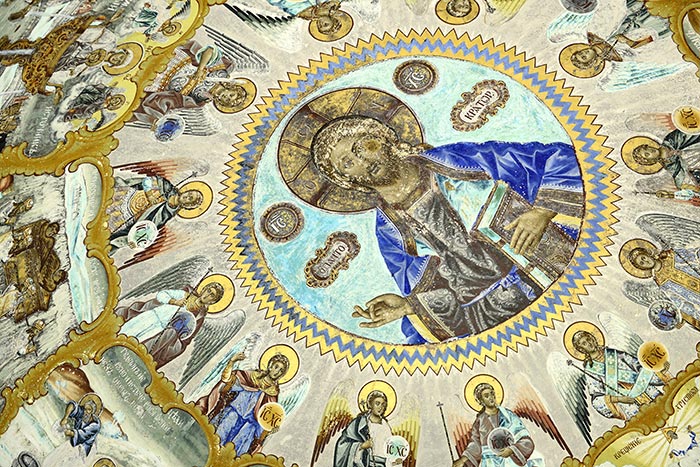
The main among the monastery’s many relics is the icon of the Tricheirousa, or Virgin with the Three Hands. According to tradition, Byzantine emperor Leo III reportedly sent forged documents to the caliph which implicated St. John of Damascus in a plot to attack Damascus. The caliph then ordered John's right hand be cut off and hung up in public view. Some days afterwards, John asked for the restitution of his hand, and prayed fervently to the Theotokos before her icon: thereupon, his hand is said to have been miraculously restored.
In gratitude for this miraculous healing, he attached a silver hand to the icon, which thereafter became known as the "Three-handed", or Tricheirousa. A copy of the icon was sent to Russia in 1661, from which time it has been highly venerated in the Russian Orthodox Church.
Among other important relics are icons of the Virgin called the Papadiki and the Akathistos, and the mosaic of the Hodegetria, or Virgin Who Guides. The library holds 181 Greek and 809 Slavic manuscripts, about 20 000 printed books (3 000 in Greek language). Helandar has jurisdiction over the historic cells of Typikarion and Molyvdokklisia near Karyes.
On March 4, 2004, there was a devastating fire at the Helandar monastery, with approximately 50% of the walled complex destroyed in the blaze. The blaze damaged the northern half of the walled complex, including the bakery. The library and the monastery's many historic icons were saved or otherwise untouched by the fire. Vast reconstruction efforts are underway, to restore fully Hilandar.


